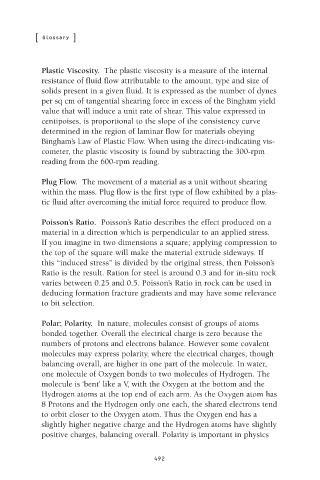Page 516 - Practical Well Planning and Drilling Manual
P. 516
Appendix NEW! revised 11/00/bc 1/30/01 3:30 PM Page 492
[ ]
Glossary
Plastic Viscosity. The plastic viscosity is a measure of the internal
resistance of fluid flow attributable to the amount, type and size of
solids present in a given fluid. It is expressed as the number of dynes
per sq cm of tangential shearing force in excess of the Bingham yield
value that will induce a unit rate of shear. This value expressed in
centipoises, is proportional to the slope of the consistency curve
determined in the region of laminar flow for materials obeying
Bingham’s Law of Plastic Flow. When using the direct-indicating vis-
cometer, the plastic viscosity is found by subtracting the 300-rpm
reading from the 600-rpm reading.
Plug Flow. The movement of a material as a unit without shearing
within the mass. Plug flow is the first type of flow exhibited by a plas-
tic fluid after overcoming the initial force required to produce flow.
Poisson’s Ratio. Poisson’s Ratio describes the effect produced on a
material in a direction which is perpendicular to an applied stress.
If you imagine in two dimensions a square; applying compression to
the top of the square will make the material extrude sideways. If
this “induced stress” is divided by the original stress, then Poisson’s
Ratio is the result. Ration for steel is around 0.3 and for in-situ rock
varies between 0.25 and 0.5. Poisson’s Ratio in rock can be used in
deducing formation fracture gradients and may have some relevance
to bit selection.
Polar; Polarity. In nature, molecules consist of groups of atoms
bonded together. Overall the electrical charge is zero because the
numbers of protons and electrons balance. However some covalent
molecules may express polarity, where the electrical charges, though
balancing overall, are higher in one part of the molecule. In water,
one molecule of Oxygen bonds to two molecules of Hydrogen. The
molecule is ‘bent’ like a V, with the Oxygen at the bottom and the
Hydrogen atoms at the top end of each arm. As the Oxygen atom has
8 Protons and the Hydrogen only one each, the shared electrons tend
to orbit closer to the Oxygen atom. Thus the Oxygen end has a
slightly higher negative charge and the Hydrogen atoms have slightly
positive charges, balancing overall. Polarity is important in physics
492

